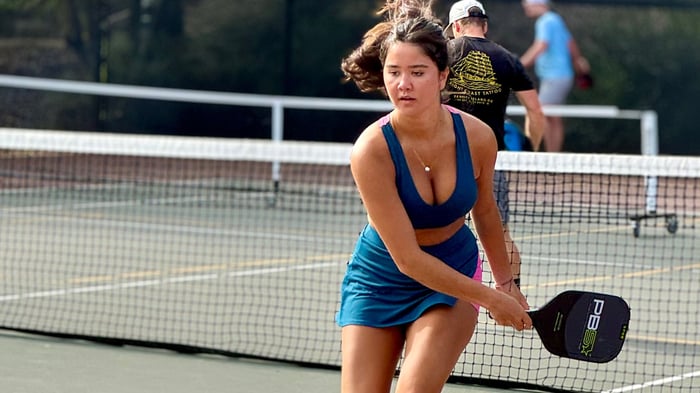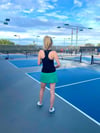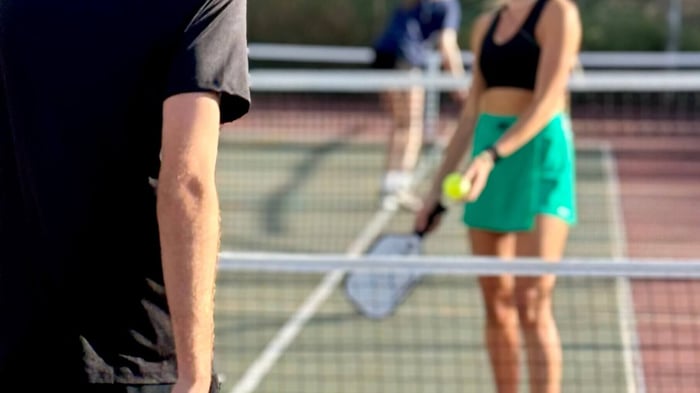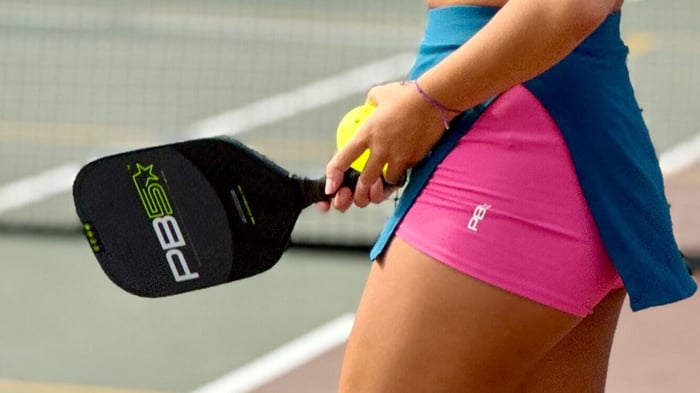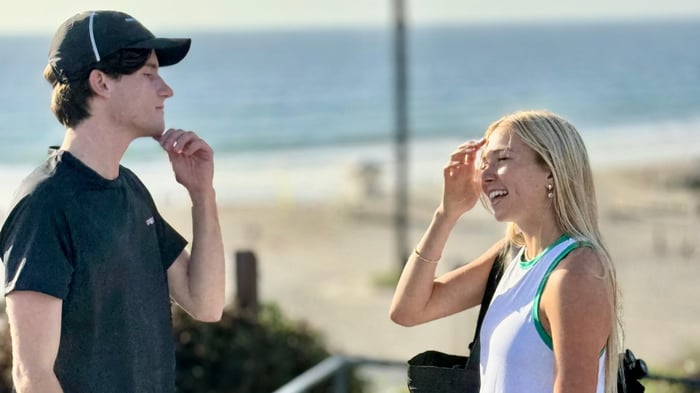Key takeaways:
You don’t need a complicated gym plan. A few full-body movements done consistently can make a noticeable difference on the court.
Strong legs, a stable core, and an engaged upper body are the foundation. These are the muscle groups that drive balance, control, and recovery during play.
Two or three short strength sessions a week is plenty. The key is staying consistent and building a routine that fits your schedule.
When you're sprinting for a drop shot or pushing through a third-game tiebreaker, your body needs more than quick reflexes. It needs strength, balance, and the stamina to keep moving with control even as you start feeling tired. That's where strength training comes in.
This article walks you through how to strength train for pickleball in a way that helps your game. You'll learn which exercises target the muscles that matter most, how to build a routine that fits your week, and why recovery matters as much as reps. Strength work supports every part of your game—helping you stay balanced, move efficiently, and manage your fatigue.
If you're looking for gear that can handle your workouts and court sessions, you're in the right place. PB5star's performance apparel is made to keep up with the way you move, train, and compete.
Foundational strength exercises for pickleball
You don't need a complicated routine to build real strength for the court. These basic movements are your starting point—they help you move better, feel stronger, and stay more stable in every match you play.
Here's how to target the three major areas that drive court performance: your legs, core, and upper body.
Lower body
Split squats – Improve single-leg strength, critical for balance during lunges, wide reaches, and abrupt direction changes.
Lunges – Target quads and glutes while training your body to stay stable during unpredictable footwork. Add side lunges to prepare for lateral coverage.
Calf raises – Strengthen the muscles that power your takeoffs and stabilize your landings. Strong calves support smoother transitions and reduce the risk of rolled ankles.
Core
Planks – Build full-body stability and improve posture. A solid plank trains deep core muscles that activate during every volley and return.
Russian twists – Strengthen rotational control used during forehand and backhand swings.
Glute bridges – Fire up the glutes and lower back to reinforce hip drive and trunk control.
Upper body
Push-ups – Work your chest, shoulders, and triceps for better paddle control and shot strength.
Rows (dumbbells or bands) – Strengthen your upper back and promote good posture. They are especially helpful for staying grounded through dinks and long exchanges.
Shoulder raises – Improve shoulder endurance and help prevent strain during serves and overhead smashes.
Training tip: Start with 2–3 sets of 8–12 reps, resting 30–60 seconds between exercises. Use light to moderate resistance and prioritize control over speed, especially early on.
Pickleball-specific strength drills
Once you've built a base with the essentials, it's time to get more specific. These drills are designed to feel like extensions of your court time—helping you move, rotate, and recover like you would during a real match. They're designed to help you train for the exact movements pickleball throws at you—quick pivots, bursts of speed, and sharp directional changes.
Incorporate the following exercises into your routine 1–2 times per week. They don't require much equipment and can be done at the gym, court, or even at home.
Rotational medicine ball throws
Pickleball is full of rotational movements—every forehand, backhand, and quick torso pivot starts from your core. This drill trains explosive rotation and power transfer from your hips to your arms and improves the control behind your shots.
How to do it: Stand sideways about 3 feet from a wall, holding a 4–8 lb medicine ball. Rotate your torso away from the wall, then drive through your hips and core to throw the ball against the wall. Catch it on the rebound and reset.
Why it works: Builds rotational strength and timing used in forehands, overheads, and passing shots. Also engages your glutes and stabilizing muscles.
Tip: Exhale on the throw to encourage power through your core, not just your arms.
Lateral band walks
In pickleball, you constantly move side to side—guarding the kitchen line, shifting for a return, or reacting to a well-placed dink. This drill helps you improve at those quick lateral steps by strengthening the muscles that keep your hips and knees steady as you move.
How to do it: Place a resistance band around your thighs (or ankles for more challenge). Lower into a partial squat and take small, deliberate steps to the side—10–15 steps each direction.
Why it works: Strengthens the glute medius and hip abductors, essential for stable, injury-resistant side-to-side movement. The PB5 Court2 shoes offer the right mix of grip and cushioning for lateral moves and recovery drills.
Tip: Keep your toes and knees pointing forward to avoid overcompensating with your knees or lower back.
Single-leg deadlifts
Quick changes in direction test your balance and coordination, especially during lunges or wide reaches. To stay in control, you need strength in the right places. This drill helps you build that balance by working your hamstrings, glutes, and lower back muscles. It's especially helpful when reaching wide, shifting your weight, or recovering quickly between shots.
How to do it: Hold a light dumbbell in one hand, stand on the opposite leg, and hinge at the hips as your free leg extends behind you. Keep your back flat and core engaged as you lower the weight toward the floor, then return to standing.
Why it works: Enhances balance and strengthens the posterior chain—helping with smoother footwork, more stable landings, and better control during stretches or dives.
Tip: Start by practicing next to a wall for balance. Focus on slow, controlled motion to build stability before adding speed or weight.
How to add these drills to your week
Pair them with strength workouts: Add one or two of these exercises after your main lifts when your muscles are warmed up.
Use them as activation drills: Perform a light set of each before hitting the court to prime your muscles for gameplay.
Rotate through them: Choose one or two to focus on each week, then cycle in new ones to keep your routine fresh and balanced.
These drills train your body for the movements you'll use point after point—fast pivots, lateral shuffles, and quick recoveries. As you work them into your routine, you may move more decisively, hold your positioning better, and stay in rhythm through longer rallies.
Building a smart training routine
You can build strength without following a rigid or intense plan. The key is finding a rhythm that fits into your week, supports how you move on the court, and keeps you feeling fresh. With the right approach, your workouts can support your time on the court and help you show up feeling strong, not drained.
How often to train
Aim for 2–3 strength sessions per week, spaced out so your body has time to recover in between. That break between sessions helps your muscles rebuild and keeps you from feeling worn out.
If you're already playing several times a week, don't overdo it—adjust your strength workouts so they fit your schedule. It's better to be consistent with short, manageable workouts than to go hard one week and disappear the next.
Workout structure
Every session should follow a clear structure: warm-up, train, recover.
Start with a dynamic warm-up to get your body moving and loosen stiff joints. A few minutes of jumping jacks, leg swings, or shoulder rolls will help you ease into your session.
Then move into 4–6 full-body exercises that cover your legs, core, and upper body. Go for compound movements like squats, rows, and planks—these target multiple muscles at once and keep things efficient.
Finish with a cool-down that includes some light stretching or foam rolling. This simple step can help you recover faster and feel less sore before your next session.
How to progress
Progress doesn’t always mean going heavier. Adding control, refining form, or increasing volume slightly can build the kind of strength that holds up over time and lowers your risk of setbacks.
What matters most is how it carries over to the court. If you're navigating the court more comfortably, holding your pace deep into games, or reacting with less hesitation—that's a sign you're building the right kind of strength.
Use those changes as your signal to keep building. Your workouts should always support how you play, not just how much you can lift or how long you can go. Two focused workouts a week—built around strength, movement, and recovery—can improve how you feel on the court without overwhelming your schedule.
Training for recovery and longevity
Training gets you started, but recovery keeps you going. Without it, fatigue builds up faster, and the risk of setbacks goes way up. Making time for recovery is essential if you want to stay strong and consistent on the court.
Here are some simple ways to recover well and stay ready for the next session:
Active rest days: Go for an easy walk, stretch on the living room floor, or do some light yoga—just enough movement to keep your body loose without adding stress.
Prioritize sleep: Your body does most of its recovery while you sleep. Aim for 7–9 hours each night so your muscles have time to repair and recharge.
Hydration and fuel: Drink water throughout the day, especially after workouts. Pair that with a meal or snack with protein and healthy carbs to help your body recover.
Wear gear that helps you recover: Lightweight, breathable clothes and cushioned shoes make training more comfortable and help your body cool down and reset. The Core Performance Tee is a great choice for this, made with soft, moisture-wicking fabric that keeps you dry and comfortable through workouts.
Stretch, roll, and reset: Foam rolling after a session helps loosen tight spots. Follow that with a few slow, steady stretches to keep your muscles feeling fresh.
Good recovery habits help you train consistently and show up with more to give, match after match.
Quick answers: Strength training FAQs
If you're getting into strength training and trying to figure out how it fits your pickleball routine, you're in good company. Here are a few quick answers to common questions that come up when players start building a strength routine.
How long until I see results?
You'll most likely see results within 3-6 months with consistent training. You might feel quicker on your feet, recover faster, or have better control during long points. It's less about what the scale says and more about how your body feels when you play.
What's the minimum I need to do?
Two short sessions a week—around 30 minutes each—are enough to make a difference. Focus on full-body moves like squats, rows, and planks. Stick with it, and you'll feel the results on the court.
Can I train effectively at home?
Definitely. Even without a gym setup, you can make serious progress with just a little space and basic gear. Practicing strength drills at home builds muscle memory, sharpens movement, and keeps your skills from getting rusty between games.
How do I avoid overtraining?
Don't try to do it all at once. Space out your strength work and court sessions, and listen if your body starts feeling run down. Rest, sleep, and a little stretching go a long way in keeping you consistent.
What's the best way to warm up before strength training?
Start with a few minutes of movement to get your blood flowing—think jumping jacks, a brisk walk, or a light jog. Then, do some dynamic stretches like leg swings or arm circles. It doesn't have to take long, but it makes a big difference once you start lifting.
Power up your game with smarter training
Strength training builds control and durability that really shows up once you’re in the middle of a match. It helps you move more efficiently, stay balanced through long points, and feel like you’ve still got gas in the tank when the game gets tight. Nothing complicated—you just need a routine that hits the right muscles, works with your schedule, and keeps you coming back.
What you wear when you train matters too. PB5star’s performance gear is built to keep up with you—through every lift, sprint, and rally.



